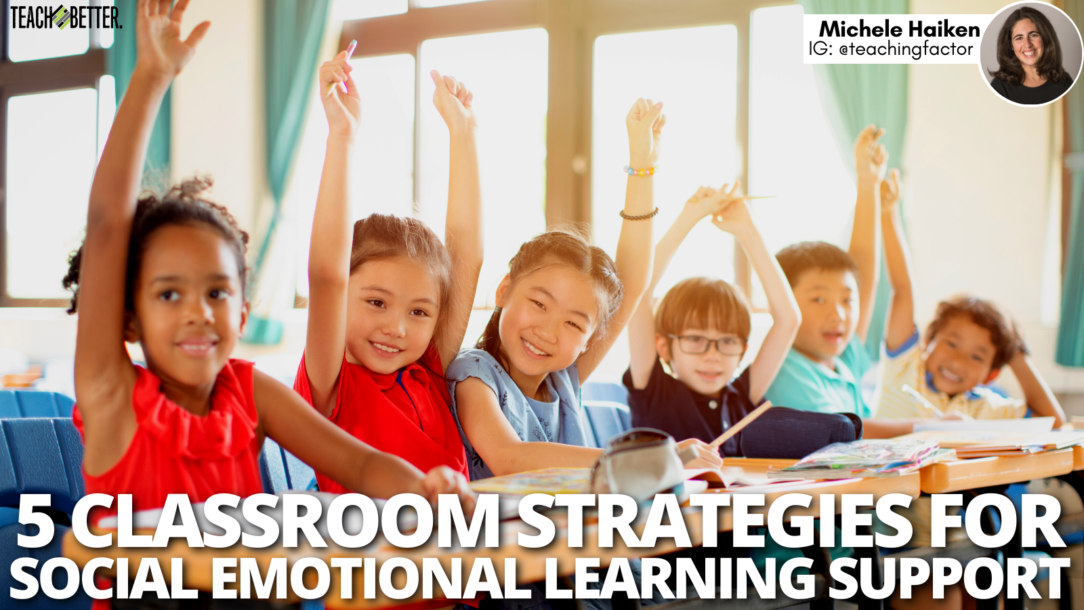TL;DR:
- Social emotional learning is already integrated into everyday teaching, helping students develop essential life skills alongside academic knowledge.
- Teachers can enhance SEL by implementing intentional strategies, such as reflection for self-awareness, authentic assessments for social awareness, choice boards for responsible decision making, checklists for self-management, and promoting collaboration and cooperation for building relationship skills.
- These practices align with CASEL’s five tenets of Social Emotional Learning. They empower students to develop healthy identities, manage emotions, establish empathy, maintain supportive relationships, and make responsible decisions.
Social Emotional Learning Support
Social emotional learning does not have to be an add-on curriculum. It is already embedded in the teaching we do every day. School is about teaching the whole person. That means life skills and lifelong guidelines are part of our disciplinary curriculum. While students are studying earth science they are learning to take notes which are executive functioning skills and self-management competency.
Participating in a Socratic Seminar in history class, students practice active listening and build communication skills. This helps to develop relationship skills and social awareness. In English, students are reading about how characters persevere and cope with adversity. This models self-management and responsible decision making. These are just some of the ways that teachers are helping to meet the five tenets of social emotional learning as defined by Collaborative for Academic, Social, and Emotional Learning (CASEL).
SEL is the process through which all young people and adults acquire and apply the knowledge, skills, and attitudes to develop healthy identities, manage emotions, and achieve personal and collective goals, feel and show empathy for others, establish and maintain supportive relationships, and make responsible and caring decisions. With some intentional teaching moves all teachers can empower students to learn deeply about their world, themselves, and others. The five practices below are based on each of CASEL’s five tenets of Social Emotional Learning.
#1. Reflection Builds Self Awareness
After a unit or summative assignment, I usually have students complete a reflection to help them judge for themselves how hard they worked, how hard they tried, and the quality of the world they contributed. These three aspects of reflection are recommended by Daniel T. Willingham in his book Outsmart Your Brain (2023). Reflections can be in the form of short answers on a Google Form or in writing. You might consider a scale for students to rate their work effort. When students write about their experiences and opinions, they are developing a metacognitive awareness about themselves as a learner. When students are able to honestly share their strengths and weaknesses as learners, they build self-awareness.
Social emotional learning does not have to be an add-on curriculum. It is already embedded in the teaching we do every day. School is about teaching the whole person. Click To Tweet#2. Social Awareness & Authentic Assessments
Connecting content to current events helps students develop a social awareness about the world around them. Instead of just writing an essay or taking a test to evaluate what students know and have learned, consider assigning a podcast about a topic that students are passionate about to build persuasive and informative communication skills. I always ask students what they want to change about the world. Some consider war, the environment, and even mental health. Students research the topic and then create a storyboard to either create a mini-documentary about their topic or public service announcement.
We study elements of both digital storytelling genres and then students choose a movie-making app like Adobe, Powtoons, or iMovie to effectively communicate their message. While completing this assessment, students are reading, researching, writing, speaking, listening, thinking critically, and leveraging technology for constructing knowledge and creative design. So, students are only meeting content area standards but harnessing interpersonal and social skills.
#3. Choice Boards Facilitate Responsible Decision Making
Providing choice in your assignments and assessments helps students navigate responsible decision making for themselves and also their classmates when collaboration is involved. Learning menu choice boards (menus, tic-tac-toes, Totally 10 choice boards) provide options for students. Our goal as teachers is to figure out how to teach the same content through a student’s choice of instructional experiences. Our objective is to get all students engaged and that means all students must have high attention and high commitment. One of the best and most manageable ways is through choice boards and learning menus. When providing choice, students have to make constructive decisions and weigh options as they pertain to themselves and others.
#4. Checklists Help Develop Self-Management Skills
When designing units of study or multistep assessments, providing students with checklists is helpful to organize the work and time management. Consider it a scaffolded road map to support students with check boxes or bullet points. While a checklist helps students manage their time with projects or assignments, it also helps to bolster executive functioning skills.
[scroll down to keep reading]
#5. Cultivating Relationship Skills With Collaboration & Cooperation
Collaboration and cooperation are life skills necessary in school. Teachers cannot expect students to know how to effectively collaborate. These lessons are cultivated throughout the school year at every grade level. Teach students how to work in groups by highlighting speaking stems or frames when students work together. With group projects, students rate themselves and their group members. Provide explicit instructions and feedback.
When observing a group working really well together, announce to the class, “I noticed that when Sasha and Luke were discussing the questions, Sasha stopped and said we haven’t heard from Osman yet, let’s give him the opportunity to share what he thinks.” This small move helps students learn what it means to work in a group and by showcasing positive examples, students are able to build positive relationship skills through collaboration and cooperation.
Social Emotional Learning has been evolving over an extended period of time and with simple intentional strategies, teachers can embed these key skills into any content area classroom to support learner success. Creative communication and cooperation elevate learning experiences and support student engagement, learning, growth, and achievement.
About Michele Haiken
Michele Haiken, Ed.D is an educator, author, and blogger. She has been teaching for more than twenty four years as a middle school English teacher and an adjunct professor in New York. Michele is the co-author of the forthcoming book Creative SEL: Using Hands-on Projects to Boost Social Emotional Learning (ISTE, 2023) and author of New Realms for Writing (ISTE, 2019), Personalized Reading (ISTE, 2018), and editor of Gamify Literacy (ISTE, 2017). Michele is passionate about empowering 21st Century learners, educational technology and literacy so everyone can reach excellence. Read more on her blog theteachingfactor.com and connect with Michele on Instagram @teaching_factor and Twitter @teachingfactor.



